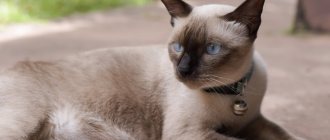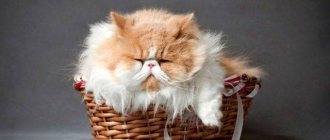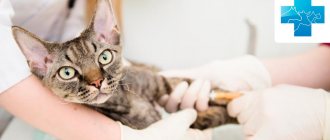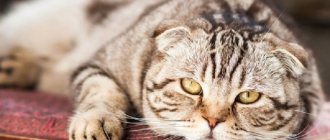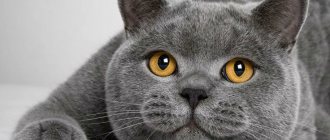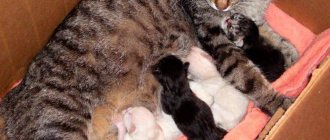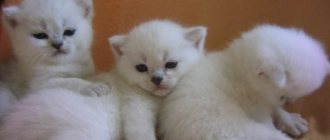11977Administration
Representatives of the British breed are considered strong animals that are quite capable of living a healthy life for about 10 years. Many people are interested in how long British cats live in the modern world. Life expectancy can be either more or less than this number. It all depends on a large number of factors, which you can familiarize yourself with on our portal.
From 10 to 15 years, how long do British breed cats live? By cat standards, this is really a lot, but 1 year of an animal is not equivalent to 1 year of a person.
But even here the British differ from other breeds, since 1 year of life of this breed is equivalent to 15 years of a person.
If you think about the lifespan of your pet, this means that you need the cat to be with you as long as possible. You can have no doubt about the life expectancy of your pet, know that everything is in your hands! From our side we can say that on average the average British cat lives 15 years with proper care.
© shutterstock
Factors that influence the age of a pet
This breed is very beautiful and such pets, as a rule, are kept to participate in various competitions or to breed new offspring. Such pets do not survive on the street, as they are gentle and very domestic creatures . British cats live best at home and with proper care.
The following factors influence how long British cats live:
- genetic predisposition to certain diseases;
- living conditions of a cat;
- food;
- the presence of stress.
The British have a well-developed immune system by nature, but nevertheless, they are susceptible to some diseases. Diseases can be transmitted from other felines or even from people.
Living on the street significantly shortens an animal's lifespan. It is also reduced by stress, infections, cat fights and bad food. Oncological diseases are not typical for this breed.
Breed Features
The homeland of the British is Italy and Egypt.
The unusual appearance of the animals made them real kings of exhibitions. Representatives of the breed have a large body with well-developed muscles and “plush” fur that is unusually pleasant to the touch. The British have a wide, muscular back. The tail is thick, somewhat tapering at the tip. The ears are erect, slightly rounded. The coat is short, with a thick undercoat. However, there is also a long-haired variety of the British. The color can be anything: from white to black, like ebony. The most common colors are smoky blue and striped. The cats of this breed of “Siamese” color, or colorpoint, are very beautiful.
Cats are friendly with family members and get along well with other pets. They are wary of strangers. However, once you understand that the stranger does not pose any threat, the good-natured Briton begins to caress and purr.
The British get along well with children. Fans of the breed even compare them to nanny dogs, such as German shepherds or collies. Throughout their lives, cats remain playful, but the character of these cats is unobtrusive. They do not try to win the attention of the owner, however, they never refuse outdoor games.
Much does not mean good
What’s strange is that your excessive care and love for a short-haired animal can also shorten its life. Owners of such animals very often pamper their pet with a variety of treats and protect it from external factors.
The reason for this is overeating, which does not in any way affect the good health of the pet. As for protection from external factors, this can reduce the pet’s immunity and lead to various diseases.
© shutterstock
Regarding reproductive functions, they also affect how long your cat or your female will live. always live much shorter than ordinary pets . And food! It plays a huge role in this topic!
How to extend the life of an animal
How long British cats live depends on their owners. An animal with ideal genetics can die early due to improper care. But it won’t live on the street for even 5 years. Vitality, strength of the immune system, and psychological well-being depend on the content. By creating good conditions for your pet, you can significantly extend its lifespan.
Diet
A balanced diet increases the length and quality of life.
Britons are prone to obesity. You should limit the amount of fat. Overfeeding your pet is strictly prohibited. But animals have a good appetite. They may often demand that the bowl be filled. If the owners cannot refuse and begin to pamper the pet, the animal quickly gains excess weight.
The basis of the diet should be premium and super-premium food. The best option is food created for the British breed (marked “Brit”). On the packaging of any food there are instructions for calculating portions. Do not overfeed the animal; carefully calculate the diet.
Buying cheap food from the mass market shortens the life of your pet.
The composition of cheap feed is not balanced. It cannot meet the animal's needs for vitamins and microelements. Prohibited foods include pork, which is very difficult to digest. River fish are prohibited because of their small bones, which are easy to choke on. Milk is allowed for kittens up to 6 months, but not for adults .
A British cat should be fed twice a day. The diet should not include ready-made food from the human table. This is fraught with obesity and the development of problems with the digestive system. The list of permitted human products is very short:
- lean types of meat;
- lean sea fish;
- egg yolks;
- low-fat kefir and cottage cheese;
- porridge, except oatmeal and semolina;
- premium baby food.
Keep in mind that the British have a short muzzle. They can only grab small pieces of meat. A balanced diet includes 70% dry food and 30% wet food. Make sure that the drinking bowl does not remain empty. Change dirty water promptly.
Many owners disagree with these rules. Sometimes people feed animals table food or cheap food. And they say that even without food restrictions, the British live a long time. This opinion is wrong.
If a cat lived 15 years on a poor diet, it could live up to 19 or 20 years on a good diet.
Hygiene
- A British cat should be brushed every day. Otherwise, the stomach will become clogged with clumps of wool.
- Once a month you need to trim your nails. But complete declawing is unacceptable.
- The eyes should be cleared of pus every week or more often if necessary. Cleaning is done with a cloth soaked in warm water.
- The ears should be cleaned once every 2 weeks. A cotton wick is used for this purpose.
- You need to brush your teeth 1-2 times a week. Regular brushing prevents possible problems with teeth and gums.
- Beds, bowls and trays should be cleaned when they become dirty.
Physical activity
A healthy animal needs space to be active. The cat needs a spacious walk. It is harmful to lock it in a confined space. This leads to muscular dystrophy and excess weight gain. Obesity creates additional stress on the cardiovascular system. This leads to accelerated wear and tear of the body. But you can’t walk a cat on the street, it’s dangerous for the animal. The animal should be given enough space inside the house or apartment.
Disease Prevention
To prevent some diseases you need to get vaccinated. You can obtain a schedule of mandatory vaccinations at your veterinary clinic. Timely vaccinations protect against the following diseases:
- rabies;
- panleukopenia;
- calcevirosis;
- rhintracheitis;
- chlamydia and lichen.
Some cat diseases are common to humans and animals. The life of the pet and the well-being of the family depend on compliance with the vaccination schedule. Britons under 8 years old should visit a veterinarian at least once a year, over 8 years old - 2 times a year. If any signs of illness appear, contact your veterinarian immediately. Diseases do not go away on their own, but progress over time.
Castration (sterilization)
Spayed and neutered cats live longer. If you own a non-breeding animal, surgery should be performed. This will help preserve the dignity of the breed, extend the life of the pet, and solve the problem of unplanned offspring. Optimal age for the procedure: 7–8 months.
The operation prolongs life by an average of 2–3 years.
A well-performed operation does not have negative health consequences. The harm of castration or sterilization is a myth. Such rumors arise after contacting unqualified surgeons. Either due to improper care after castration or sterilization.
Psychological well-being
The British are stressed . The animal should be protected from unpleasant experiences. These include walking on the street, being left alone, and being in contact with many strangers. But visits to the veterinarian, vaccinations and surgeries are necessary procedures that should not be neglected.
For your pet’s psychological well-being, you need to communicate and play with it often. Britons can remain active into old age. The behavior of adult animals often resembles that of kittens. If the owner ignores the cat, it becomes passive and lazy. And the time spent with a person, his attention and love received, extend the life of the pet.
Tips for increasing your pet's lifespan
Proper care of representatives of the British breed is the key to a happy and long life for your pet. First, you need to always monitor the living conditions of your male or female cat. Remember that cats live much better at home.
That is why the room in which the cat lives must be ventilated, and the temperature in the room must be stable, as well as the humidity. A cat's physical activity can also increase or decrease its lifespan. Provide your pet with a place to play and the right number of toys.
Don’t forget to also work with him yourself, give your pet enough attention!
Do you want your pet to live happily ever after? Follow these rules:
- Fresh air. Let your pet out on the balcony or veranda!
- provide good nutrition for the British people. Add grass, vitamins and various useful additives that are found in premium food to his diet.
- mobility! Play with your pet as often as possible. Let him throw out his energy.
© shutterstock
Next we will go through all these points in detail.
In the second point, we mentioned that food plays a direct role in a cat's lifespan. Don't forget to wash your pet's dishes and change their bowls frequently. Buy only fresh and high-quality products. Different meats are suitable for different breeds, but we recommend feeding the British with lean meat . Chicken and beef are also suitable for the diet of this breed.
If you do not have time to search for meat, and you want to buy regular food, then buy the food that is designed specifically for this breed. These types of food, as a rule, come in smaller packages than food for other breeds.
Life expectancy in British cats
The popularity of this breed is well justified. They have good health and a pleasant and comfortable character.
Attractive appearance also contributes to the growth of love for such pets.
The use of other breeds in breeding indicates genetic diversity.
When choosing a pet, lifespan is always important.
If in many dog breeds the average lifespan is up to 10 years, then in cats the life expectancy often reaches 17-19 years.
This is facilitated by the small size and flexibility of the cat’s psyche. It’s not for nothing that they talk about the 9 lives of a cat.
They recover from falls from great heights and travel across the country for their owners.
This is interesting: Blue Solid Maine Coon: let’s get to know it in general terms
Food size
This is due to the small jaw size of cats. Smaller food is simply easier for them to chew. If you can't find small food, you can buy wet food. But remember that the food, as we wrote above, must only be from an expensive and reputable company. Such manufacturers include in their products the very vitamin minerals, proteins and meat that your pet needs.
Since we have already remembered the topic of vitamins, we need to consider it in more detail. There are a lot of vitamins, and they differ only in their varieties, namely: vitamins for castrated animals, vitamins for strengthening teeth and bones, and so on.
Just like people take medications, you should always consult your veterinarian before purchasing vitamins for your pet! He will advise you on the best vitamins.
By following all the above tips, you can increase the life expectancy of British cats at home.
© shutterstock
Possible diseases
The artificially raised breed of British cats has good health and good endurance. But pets are prone to diseases, both genetic, congenital and acquired.
The most common diseases of British cats:
- Genetic diseases of British cats
- Pathologies of the eyes and ears with viral and bacterial conjunctivitis and inflammation of the ears.
- Helminthiasis caused by parasites.
- Skin diseases: ringworm, other mycoses.
- Gastrointestinal diseases with gastritis, causing inflammation of the gastric mucosa. With panleukopenia caused by infectious infections,
- Joint pathologies with dislocation or arthrosis of the affected joint.
- Cardiovascular failure, which leads to: shortness of breath, wheezing, fatigue.
- Kidney diseases. Urolithiasis is common and dangerous.
Why does a British cat shed a lot?
It is common for the cat family to periodically shed their fur; shedding is a natural process characteristic of autumn. British, a fluffy breed with a dense undercoat, short hairs often die and fall off. When a British cat sheds a lot, it happens for many reasons, both physiological and provoked by the circumstances of grooming. The most common ones include:
- Allergies are caused by various reagents: household chemicals, shampoo and other care items. Dry food, food, dust, and pollen from flowering plants become irritating factors.
- A lack of vitamins leads to a deterioration in the condition of the pet’s entire body, affects the epidermis, and hairs throughout the body fall out significantly. Active supplements with a full range of vitamins and minerals prescribed by a veterinarian will biologically help restore nutritional balance.
- Pregnancy and the postpartum period are especially difficult for a British woman. Nursing kittens leads to increased consumption by the body of nutrients and vitamins necessary for the development of the fetus. During this period, it is important to regularly and comprehensively replenish your reserves of nutrients.
- Mycoses, ringworm are dangerous fungal diseases. When infected, the pet itches, the fur falls out in clumps with the appearance of redness and inflammation.
- It is important for your pet not to have an unbalanced diet. It is forbidden to feed your cat food that contains salt, spicy, smoked foods and seasonings. Such food leads to indigestion, allergic reactions and can cause severe shedding all year round.
- Hormonal imbalance leads to severe hair loss in the British cat. This can happen due to the pet’s old age, endocrine diseases accompanying age, or occur as a result of pregnancy and the lactation period.
Why does a British cat have watery eyes?
Tearing is a common phenomenon, and there are several reasons why British people have watery eyes:
- Helminthiasis, caused by the development of parasites in the intestines, leads to watery eyes in cats. The veterinarian prescribes anti-worm medications for the animal.
- A characteristic feature of the British cat breed is a flattened nose. Decreasing at the bridge of the nose, it provokes blockage of the tear ducts and causes the release of tears.
- An allergic reaction to various components of food leads to frequent discharge of tears from the eyes of a British cat.
Will help:
- Daily rubbing of the eyes with a weak solution of potassium permanganate or furatsilin;
- To prevent infections and allergies, use Iris, which contains the antibiotic chloramphenicol;
- They use “Diamond Eyes” drops, an excellent prophylactic for maintaining vision.
Heart failure in animals
Heart failure in cats is a violation of the functional activity of the heart muscle, which leads to a lack of blood supply to tissues and organs. In the UK, cardiac dysfunction manifests itself in two forms of heart failure:
- Acute heart failure manifests itself in a special way in cats. Heart attacks are caused by an imbalance between the functions of the nervous and endocrine systems. Severe stress is dangerous and often leads to cardiac arrest.
- Chronic heart failure occurs regardless of the cat's age. The danger of the disease lies in its slow, imperceptible manifestation, which the owner notices too late, at a severe stage. It is characterized by rapid breathing, severe shortness of breath in the cat, cats breathe with an open mouth.
The causes of chronic insufficiency in a Briton will be genetic diseases, congenital defects, as well as acquired ones caused by arterial hypertension. Disorders in the functioning of the endocrine system contribute to the development of the disease: – hyperthyroidism, diabetes mellitus, which leads to arrhythmia, cardiomyopathy. Deficiency is caused by disturbances in the pet's lifestyle: obesity due to poor nutrition, adynamia caused by inactivity, infectious diseases leading to decreased immunity.
Attention! At the first signs of heart failure in your pet, immediately contact a veterinary clinic for an urgent examination. Oxygen starvation leads to asphyxia and death of the animal.
Determining the age of a cat
If you adopted a cat from a shelter or picked it up on the street, then you probably want to know the cat's age. Your veterinarian will help you determine the age of your cat with an accuracy of up to a month. The doctor will look at the cat's teeth - if it has milk teeth, then it is a kitten and is about 1 year old. If the teeth are white, this is a young cat; in older cats and cats, the teeth become covered with plaque and begin to wear off.
You can determine the age of a cat by its whiskers - after 9 years of life, a cat’s whiskers begin to turn gray. A person can determine how old a cat is just by eye, but a veterinarian can do several tests and determine the age more accurately.
Skin diseases
Problems with the fur that cause skin diseases in the British dog often worry owners of elite pets. With careful care of animals, symptoms are detected immediately. The reasons for infection are:
- Parasites appear on the skin, such as lice, fleas, and ticks, which the pet could pick up on a walk or from the owner’s objects. If there are fleas or lice, the animal behaves restlessly, scratches parts of the body in different places, insects can be seen with the naked eye;
- Ear mites cause irritation in the ears, dark discharge appears from them, and the pet constantly scratches its face with its paws.
- Skin fungal diseases are common in animals. Ringworm is a dangerous, contagious disease for cats, manifesting itself in the form of redness on bald spots, with flakes of skin that are confused with dandruff.
- Fungal parasites, mycoses parasitize mucous membranes and skin, diagnose fungal dermatitis, stomatitis, which are contagious.
- Allergic reactions also cause itching, redness and scratching of the skin.
Attention! To prescribe the correct treatment for skin diseases, contact a veterinarian-dermatologist.
Correct, timely administration of drug treatment leads to the recovery of pets:
- against parasites: lice, fleas, ticks, special antiparasitic sprays, ear drops, collars.
- for fungi, serous, zinc, antifungal ointments are used;
- To get rid of allergies, steroids are prescribed, wounds are healed with sprays and creams;
- requires medications to boost immunity.
The pet's belly hangs
What worries owners is that the Briton has a hanging belly. This condition does not always indicate a serious illness. The basis for the formation of a hanging abdomen are different reasons:
- The skin of the abdomen sags, which is a normal natural formation and is explained by the physiology of the animal;
- Frequent childbirth with large offspring leads to stretching of the uterus and abdominal walls;
- Old age. In older cats, the skin becomes flabby, the abdominal cavity sags over time;
- A fat fold on the belly, a fat tail, is the norm among British food lovers.
- Frequent constipation also stretches the lower abdomen.
- A hanging belly often becomes a symptom of a serious disease. Dangerous signs of illness are determined by the following signs:
- worms form a colony in the intestines and stomach of an adult pet, which leads to bloating and constipation. Itching of the anus indicates the presence of worms;
- oncological disease of the gastrointestinal tract will cause sagging of the abdomen, which causes pain, rumbling, and fever;
- Infectious peritonitis causes inflammation in the abdominal cavity. This leads to serious consequences, refusal to eat, fever, convulsions, and breathing problems.
- Pyometra occurs when an infection is introduced into the uterus after childbirth, which causes purulent inflammation of the uterus with vaginal discharge and pain in the peritoneum;
- An inguinal or umbilical hernia can be hereditary or acquired, which causes damage to muscle tissue and the appearance of a soft formation on the abdomen
- — Cushing's syndrome occurs when changes in the production of the hormone cortisol, which leads to an increase in the volume of the abdomen and a deterioration in the general condition of the pet.
A little history
Today, there are several versions of the appearance of this breed. Professional felinologists are still arguing which one is more reliable. Those who want to understand how long the British cat lives will be interested in the most mysterious story. According to some reports, these are the same animals that once lived in Rome and Egypt. They were brought to the territory of the British Isles by legionnaires.
Despite the fact that the British for a long time considered them ordinary yard animals, these aristocratic beauties managed to climb to the very top of the feline class system. On July 13, 1871, the first cat exhibition took place in London, which won the approval of the Queen of England herself, who owned two blue Persians. One of the participants in this event was a mouse-colored English Shorthair. It is from this moment that we can talk about the appearance of the British breed.
We recommend reading: Corella Care and Maintenance
How long do Scottish Fold cats live?
One of the most fashionable breeds of domestic cats today is undoubtedly the Scottish Fold. These animals have short, silky to the touch, thick, beautiful fur, with very different colors. The eyes of this breed are unusually beautiful: large, expressive, and the color matches the cat’s coat color. The upper part of the ears covers the ear opening and hangs down, which is why the breed got its name.
Caring for a Scottish Fold
The Scottish Fold Shorthair is not very demanding in grooming, is not subject to heavy shedding, and sometimes needs to be brushed with a soft brush to remove loose hairs. More attention should be paid to caring for the cat’s eyes, teeth, cleaning the ears, and trimming the cat’s claws. These procedures should be carried out weekly.
Lifespan
Keeping a Scottish Fold cat at home is attractive not only because of its appearance, but also because of its fairly long life expectancy.
By nature, these cats have excellent health at the genetic level; it is this factor that determines how many years a Scottish cat lives.
According to experts, Scottish Fold cats live from 15 to 20 years. This depends on proper care, and also, of course, on the selection of food that contains all the microelements and vitamins necessary for the proper development of the pet.
Thus, how many years a Scottish fold cat will live in a house depends on the owners. Regular examination by a veterinarian, compliance with all recommendations for proper care and feeding of the animal, will provide it with a high life expectancy and the owner long-term joy from communicating with the pet.
Keeping a Scottish Fold cat at home is attractive not only because of its appearance, but also because of its fairly long life expectancy.
Contraindications to castration
Any surgical intervention has its contraindications, and the procedure for castration of cats is no exception. There are a number of aspects in which castration of British people is prohibited or must be carried out with special precautions. Whether such a procedure is acceptable for an animal will be decided by the doctor after a thorough examination and tests. What are the contraindications?
- If your pet has any illness or has recently been ill;
- Castration cannot be carried out two weeks before vaccination and two weeks after it;
- With reduced immunity, in this case you must first undergo treatment;
- Obesity is also a contraindication, so the cat must “go on a diet”;
- Any stress that the cat may have: a new animal in the family, moving, etc.
In addition, consultation with a doctor about such an operation is required if the pet is elderly or has heart problems. The doctor will determine whether castration is possible in these cases and whether it will pose a threat to the cat’s life.
How long do British people live after surgery?
The average life expectancy of British uncastrated cats is 15 years, after surgery this period increases by several years. The reason is that they are minimally susceptible to cancer, unlike “normal” Britons. Also, castrated cats cannot become infected with any disease through sexual intercourse, since they no longer need it. In addition, they no longer have the need to fight for the female, and therefore any injuries are eliminated. All this directly affects the life expectancy of the British. But there are also disadvantages - obesity, which develops due to hormonal imbalance (a side effect of the operation). But any owner can control this process: it is very important to monitor your pet’s diet.
How to feed a neutered cat?
After removal of the gonads, the production of testosterone in the animal’s body decreases, which causes metabolic disorders and the cat begins to gain weight. Therefore, his menu should be different from the menu of the “ordinary” Briton.
A castrated pet should be fed exclusively with food specially formulated for castrated cats. But that’s not all: it is necessary to exclude fish from his diet and reduce portions of fermented milk products, and it is better not to give milk at all, so as not to upset the balance of phosphorus and calcium, only water. Britons should drink plenty of fresh running water.
Whether a British dog needs to be neutered is something that every owner of a furry pet decides for himself. This procedure is not at all necessary, but is desirable, especially if you do not plan to continue the pet’s family. After the operation, complete recovery occurs after three days. During this period, it is very important to take care of the cat: talk to him gently, do not allow him to get up, keep him away from drafts, pet him and often feed him in small portions.
